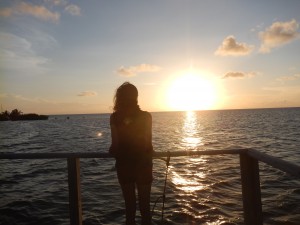Scrolling through pictures of both corals reefs and the tropical rainforest, it’s clear that both are incredibly lush environments that host diverse sets of organisms. But through this course, I’ve realized that there are more subtle similarities between the two. In the Chiquibul, we studied how the tropical soils are somehow able to sustain a diverse ecosystem while being incredibly poor in nutrients. These soils are paralleled by the oligotrophic, or nutrient-poor, waters of Glover’s Reef; both inexplicably provide a home for thousands of organisms while seemingly offering no sustenance. However, both of these habitats are characterized by rapid nutrient turnover. For every fish or insect we see, there are millions of others living organisms like microbes that exist outside of human view. The key to both of these habitats’ success seems to be this system of efficient nutrient cycling, which leaves the area nutrient-poor but the animals themselves nutrient-rich.
Perhaps even more importantly, these two ecosystems are tied together by their impending destruction. Both Glover’s Reef and the Chiquibul are faced with problems of illegal extraction and habitat loss for a number of organisms. The biology of deforestation and coral bleaching may act in different ways but the cause is the same: humans. Conservation issues plague ecologists in both areas, as they attempt to battle the overexploitation of natural resources. Poaching and overfishing are one in the same in that they sustain a desperate human population with no other livelihood, while depleting these environments of their incredible diversity.
With that said, I did notice that human intervention in the rainforest seemed much less obvious. Since Las Cuevas was so removed from civilization, the biggest indicators of human presence were camera traps and the occasional logging truck. On the reef, however, we saw a huge amount of marine debris, acting like a red flag for mass consumerism. It’s harder to see our effects on the rainforest in a short amount of time, but the 90 lbs. of Styrofoam and bottle caps serve as a pretty blatant reminder of what we’re doing to the natural world.
Overall, this course has completely surpassed all of my expectations (entirely thanks to Scott and Adrienne and all of their hard work). Ihoped to come out with a better understanding of fieldwork, but I didn’t expect to learn nearly as much as I did about conservation or how to deal with unreliable transportation. My favorite part was probably going through our camera trap photos. After 26 miles of hiking and anticipation, the payoff of that single ocelot picture was fantastic. It really made me appreciate how hard field researchers have to work. And even now that I’m back with air conditioning and wifi, I can’t say that I had a least favorite part of this course (not even the sand flies). With every van we missed and blister we added, I think we learned to be better TFBs, and that’s not an experience I could’ve gotten anywhere else.
In five years, I may have to consult my field notebooks to brush up on specifics, but I’ll definitely remember these three things:
1. Make bold choices, and live by the motto “Screw it, let’s do it!”
2. Field work takes patience and a whole lot of sweat, but it’s worthwhile in the end.
3. Never underestimate the power of a good pair of rubber boots.
I realize that I’m writing my final blog post in the very same seat I occupied two weeks ago to hurriedly write my pre-departure post. It’s incredible how much has changed since the last time I sat here; I’m a little bit tanner and covered in a whole lot more bug bites, but more importantly, I’ve returned with a whole new appreciation for the natural ecosystems I visited. Conservation is a multi-faceted and complex process with no easy solution, but with every bit we learn about the diverse habitats of the tropics, our understanding increases.
In the words of a true Belizean, “You’ve got to see it to Belize it.”

